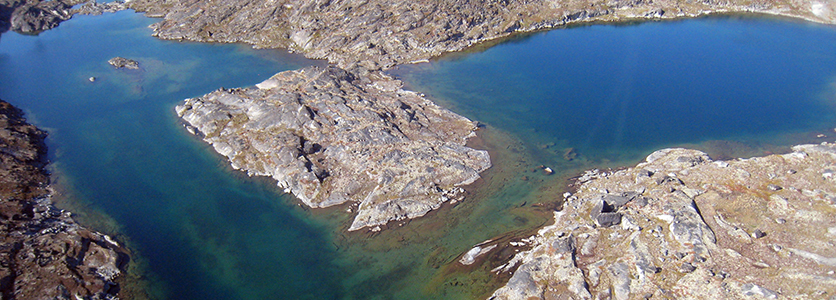
Paleoclimatology and Paleoceanography
Brad Sageman’s stratigraphic research includes studies of the sedimentary expression of orbital forcing of climate. Most of this work has focused on the rhythmic shale-carbonate facies of Cretaceous strata, especially in the Western Interior basin of the North America. A main thrust of such research is the refinement of geologic time scales - the development of floating astrochronologies based on spectral analysis of stratigraphic time series yields significant improvements, but the optimal scenario is integration of spectral analysis results with radioisotopic age dates to create anchored astrochronologies. These high-resolution time scales allow sedimentologic, geochemical and paleobiological data to be assessed within high-resolution temporal frameworks, thus significantly improving the interpretative power of such observational data. Lastly, analysis of the cycles themselves provides a window into the behavior of the climate system during past episodes of global warmth, like the Late Cretaceous, and may be highly relevant to understanding the initiation of major biogeochemical perturbations, such as ocean anoxic events, as well as the causes of global sea level changes. In addition to this stratigraphic work, Sageman also employs several geochemical tools that are useful for both stratigraphic and paleoceanographic interpretation - stable carbon isotopes and major/minor/trace element analyses are his main areas of expertise, but he collaborates with both departmental and external colleagues on a range of other proxy tools (e.g., isotopes of sulfur, calcium, strontium, chromium, osmium, etc.).
Yarrow Axford’s research takes a geologic approach to investigating the climate history of the Quaternary, up to and including present day. Quaternary sediments -- lake sediments, peats, soils, and many other geological deposits laid down within the past two million years -- provide diverse and detailed archives of dramatic environmental changes, including global-scale swings from glacial to interglacial climates and widespread human impacts on the environment. A paleolimnologist, Axford focuses much of her attention on using lake sediments to reconstruct Holocene climate changes in the Arctic, but her research group’s work also examines prior interglacials (e.g. MIS 5e or the Eemian), and abrupt climate changes during the transition out of the last ice age in Greenland and mid-continent North America. The paleolimnologist’s toolkit is broad, and may include paleoecological methods, geochemical analyses including major and trace elements and stable isotopes, glacier reconstructions, magnetostratigraphy, tephrostratigraphy, and a range of geochronological methods including radiocarbon and other radio-isotope dating techniques. Holocene climate changes can be reconstructed in remarkable detail thanks to widespread, well-preserved geological archives of this most recent phase of Earth’s history, combined with the wide range of proxies and dating methods that are applicable to this time period. Holocene climate changes thus provide exceptionally detailed, long-term “natural experiments,” addressing fundamental questions about the causes and consequences of climate change, and the role of humans in the Earth system.
Daniel Horton’s Climate Change Research Group (CCRG) uses numerical models to better understand the evolution of Earth’s climate system through geologic time. Earth system modeling of past climates can be used to simulate and assess geologically inferred climate patterns, to shape and verify observation-driven hypotheses, and to engender confidence in the ability of models to project future environmental change. On-going work in the CCRG uses Earth system models to explore the interactions of Earth’s atmosphere, cryosphere, biosphere, and lithosphere in both shallow- and deep-time settings, to include the Holocene, late Paleozoic, and Cretaceous.
Matt Hurtgen's research seeks to identify the processes that control seawater sulfate concentrations through time. The sulfate content of the ocean plays an important role in regulating the chemical composition of the ocean-atmosphere system because sulfur takes part in many biogeochemical reactions that affect the global carbon cycle. Importantly, marine sulfate concentrations have varied considerably over geologic time thereby impacting the marine carbon cycle, the evolution of Earth’s climate system, and the long-term redox balance of the Earth’s surface. To explore this theme, the Hurtgen group studies both modern and ancient sedimentary systems, integrates field observations with a variety of geochemical tools, and combines these efforts with simple geochemical models.
Neal Blair’s organic geochemical and isotopic studies of marine and lacustrine sediments have revealed the impacts of climate, tectonics, and humans in watersheds and the adjacent marine portion of the continental margin during the Holocene and Anthropocene. The interplay between land use, climate, tectonics, ecosystems and the biogeochemical cycling of C and N is the central focus of the lab’s efforts. How do the forcing functions influence the cycling, and how can we use the biogeochemical cycle signatures to reflect on the forcing functions through time and space? Field areas include the east and west coasts of the U.S., the Midwest, the Amazon delta, and the Pacific Rim.
